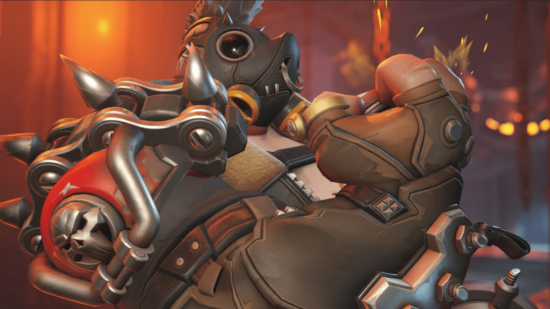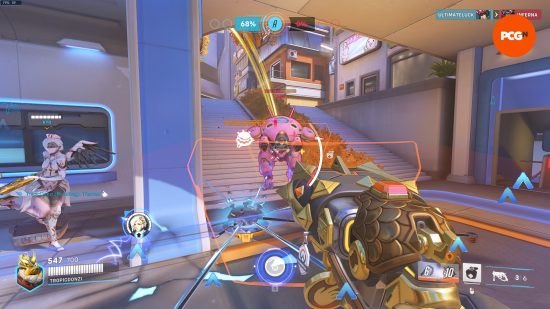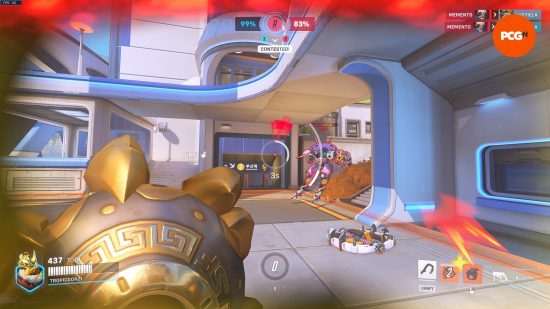Overwatch 2’s resident chonky boy just got a makeover in the form of a rework to most of his abilities and the addition of another one, Pig Pen, that has completely transformed his in-game viability. On top of that, he has already received a buff to his healing ability which, as we’ll discuss later, is his weakest point. Roadhog is now a fully fledged Overwatch 2-style tank and is extremely fun to play thanks to his newfound versatility, but a larger problem looms over his broader category of heroes: tanks.
To understand – and try to solve – Overwatch 2’s tanking problem, it’s worth figuring out why, from an average player’s perspective, this rework has made Roadhog so much more enjoyable in Blizzard’s FPS game. Overwatch 2 has had an average of one million daily active players and 25 million weekly active players in the past month (per Activeplayer.io), so it’s safe to assume that most people who play the game, even if they dabble in a few competitive games a week, are relatively casual. Blizzard must have taken notice of this, because Roadhog’s rework seems perfectly tailored to casual players who want to have fun with the character.

Roadhog has transitioned from a mostly skill-based hero, whose value resided in perfect hooks and one-shot combos, to a zoning tool that cannot be deleted from the battlefield if he receives the right support. Starting from his primary fire, his Scrap Gun has lost its secondary fire (which, let’s face it, was mostly useless apart from the absolutely random chance of one-shotting a Tracer) in favor of incorporating three large ball shaped projectiles into his shotgun-like primary fire. This is the foundation on which Roadhog’s new range of engagement is built, as it shifts the character from short-range only to being perfectly viable at mid range.
His hook remains unchanged but is now used in a slightly different way. Rather than going for one-shots on squishies (characters with 200 or less health) it’s best used as a zoning tool to pull enemies into his new trap ability, inflict big damage and set up plays with Overwatch 2’s DPS characters. Pig Pen, Roadhog’s new electric trap, plays perfectly into this style given that it’s a slowing, damaging area that enemies must avoid so as not to be deleted. Pulling in the enemy tank (especially if it’s an Orisa who has expended her Fortify) is a very effective opening move to a big fight that will consume a lot of cooldowns to be mitigated. The only downside is the length of time that the trap has to stay on the floor between the time it’s thrown and the time it can be triggered.
While his ultimate is as you remember it, and a great play of the game generator with the right map, his ability Take a Breather (the self heal) is now very different. Rather than being a one time hit, it’s now a meter, like D.Va’s Defense Matrix, that can be consumed in chunks or in one activation. It restores 500 health and gives Roadhog a 40% damage resistance, so now he has a lot of sustain during fights and can soak up more damage as a result. Much like before, Roadhog’s number one counter is Ana’s Biotic Grenade, which will prevent all of the aforementioned health regeneration. To stay antinade-proof, Kiriko’s Suzu is a must, along with a main support that knows what they’re doing – after all, Roadhog is big and takes a lot of damage while fulfilling his role of space taker and point holder.
Poking with this character at mid range and grabbing enemies into his Pig Pen is both fun and effective in most maps. His new mechanics are fairly easy to learn, and make Roadhog an effective match for most other tanks. But his rework philosophy is not a long-term solution to fixing the tank role in Overwatch 2.
Playing the big damage sponge feels like a game of rock, paper, scissors because, as a general rule, Orisa beats Roadhog, Sigma beats Orisa, Zarya beats Sigma, and Reinhardt beats Zarya – the list goes on. Now Roadhog is a player in this system (as opposed to being almost unplayable before), and, while that’s certainly a step in the right direction, it’s still not the solution to the problem.
Tanks need to be feel-good heroes that are only a little reliant on the supports to fulfill their frontline role. They need to have some form of damage mitigation (a shield, D.Va’s Defense Matrix, or Junker Queen’s life-steal), a stun to set up plays, a zoning tool, and, most importantly, a panic button to survive – like Ramattra’s form change, Junker Queen’s Commanding Shout, or Sigma’s Kinetic Grasp, for example.
Mauga, the new Overwatch 2 tank coming with next season, is the perfect example of almost hitting the sweet spot: he has great damage at both close and medium range, a stun linked to his mobility, and a way to heal himself while doing critical damage. However, he has no panic button. To eliminate the rock-paper-scissor problem, Blizzard needs to ensure that tanks (both past and present) maintain these four core pillars. Instead of wildcard new ideas, I’d rather see them innovate on what they already do well – just like they’ve done with Roadhog. Eliminate the chaos, and then player skill and expression (along with some healthy map reading) are the only factors dictating the outcome of a fight.
Now I’m not saying that every tank should be the exact same, but Blizzard (now with new and improved creative freedom thanks to the Microsoft deal) is proving that it’s aware of what needs to be done – both Roadhog and Mauga are indicative of that. Reworking old heroes more to give them the same array of options is the way to go, and ensuring new ones fit into the same general mold will help ensure there’s no OP wildcards. Sorry Big Bang Theory, but you don’t always need to add Lizard and Spock to the old rock, paper, scissors – sometimes, sticking to the basics is best.


